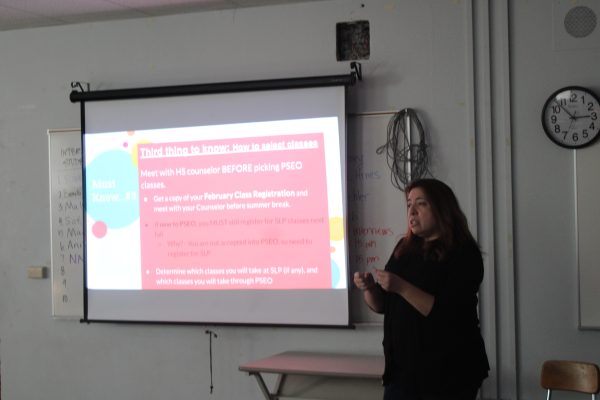A look into the timeline of COVID-19
Coronavirus’ path to becoming a global pandemic
Maggie Klaers, Talia Lissauer, and Marta Hill
April 23, 2020
Below are the transcripts to an animated video. The video is available on YouTube and embedded on this page.
COVID-19 is a new strand of the Coronavirus that was discovered in Wuhan, China in late 2019. A Coronavirus is a family of viruses, and there are seven known human Coronaviruses, according to the CDC. The virus spreads by person to person contact through things like coughs or sneezes.
It can cause anywhere from mild to severe illness, however, those with underlying conditions or the elderly are at the greatest risk, according to the CDC. Although many symptoms overlap with the flu, COVID-19 also can cause shortness of breath and trouble breathing. In addition, while flu symptoms can develop quickly, COVID-19 symptoms typically develop gradually and worsen over time, according to CNN.
In December 2019, the Wuhan province in China reported a series of unknown illnesses to health authorities. Shortly after, health officials discovered a new Coronavirus; COVID-19. The virus is believed to have started at a popular poultry and seafood market.
By Jan. 23, the virus had spread to Taiwan, Japan, Thailand, South Korea and the United States, infecting 570 people and killing 17.
As thousands of people became infected in China, the World Health Organization (WHO) declared a public health emergency Jan. 30. The United States State Department warned Americans to avoid travel to China.
A day later, the Trump administration announced it would deny non-Americans entry to the United States if they had traveled to China in the last 14 days.
By Feb. 9, the number of infected people rose 40,171, with 908 deaths, officially surpassing the amount that died from SARS during the outbreak in the early 2000s.
The first major European outbreak began in Italy Feb. 23. The number of cases quickly grew from 5 to 150 and Italy responded by shutting down 10 towns around the country.
With only 35 cases in the United States Feb. 24, the Centers for Disease Control and Prevention (CDC) warned of the potential for an outbreak. The Trump administration asked Congress for $1.25 billion to help prepare for an outbreak in the United States.
On Feb. 26, COVID-19 arrived in Latin America, brought by a Brazilian man who had recently traveled to Italy.
Global cases rose to 87,000 by Feb. 28 and the United States saw its first death due to COVID-19. The Trump administration administered a “do not travel” warning to places in Italy and South Korea. They also banned travel to and from Iran along with denying entrance to anyone who has traveled to Iran in the last 14 days.
The number of cases worldwide then rose to over 90,000 and the death toll rose to 3,000 by March 3.
COVID-19 arrives in Minnesota March 6, infecting one man who had recently been on a cruise that had a confirmed case.
March 9 the prime minister of Italy imposed a national quarantine, being the first democratic country to go on lockdown since World War II.
March 11 the WHO declared the outbreak an official pandemic, and President Donald Trump announced a travel ban to all of Europe excluding the UK and Ireland.
March 13 Trump declared a national emergency. The same day, Governor Tim Walz declared a peacetime state of emergency as the number of cases in Minnesota rose to 14.
March 14 St. Louis Park confirms its first case of COVID-19
March 15 Gov. Tim Walz orders the closing of all Minnesota schools through executive order 20-02 beginning March 18. The CDC recommends stopping gatherings of 50 people or more.
March 16 as Minnesota confirmed cases rose to 54, Walz closed all in-person restaurants, bars, and other public facilities. Take out and curbside pickup are still allowed. Trump advises Americans to avoid gatherings of 10 or more people.
March 18 Trump signs the Families First Coronavirus Response Act.
March 24 the Olympics are postponed for the fourth time in its history to the summer of 2021. Cases in the United States surpasses 50,000.
March 25 Walz announced a stay-at-home order for all Minnesota residents.
March 26 the United States became number one in the world of confirmed cases with 81,321 and over 1,000 deaths surpassing China and Italy.
March 27 Trump signed the $2 trillion coronavirus economic stimulus bill. Cases in the United States surpasses 100,000.
April 2 global cases rise to over one million with over 51,000 deaths. Cases in the United States hit 232,837, the death toll reached 5,000.
April 3 the CDC and the White House advise Americans to begin wearing cloth face covering.
April 4 the number of confirmed cases in the US rises to 300,000 and the death toll reaches 8,000.
What can be done?
In order to prevent the spread of COVID-19, officials say we need to flatten the curve. Flattening the curve refers to the two general ways COVID-19 could play out. The tall curve is if we do nothing. The pandemic will likely end sooner, but the number of infected cases will surpass the hospital capacity including the number of beds and supplies available, likely killing millions worldwide. The second curve is demonstrating what will happen if we all do our part and take necessary precautions like social distancing. Fewer people will likely be infected over a longer period of time.
The number of cases nationally and worldwide is exponentially increasing, and since there is no cure or vaccine yet, individuals and governments need to take precautions in other ways to flatten the curve. Individuals can do their part by participating in social distancing.
















